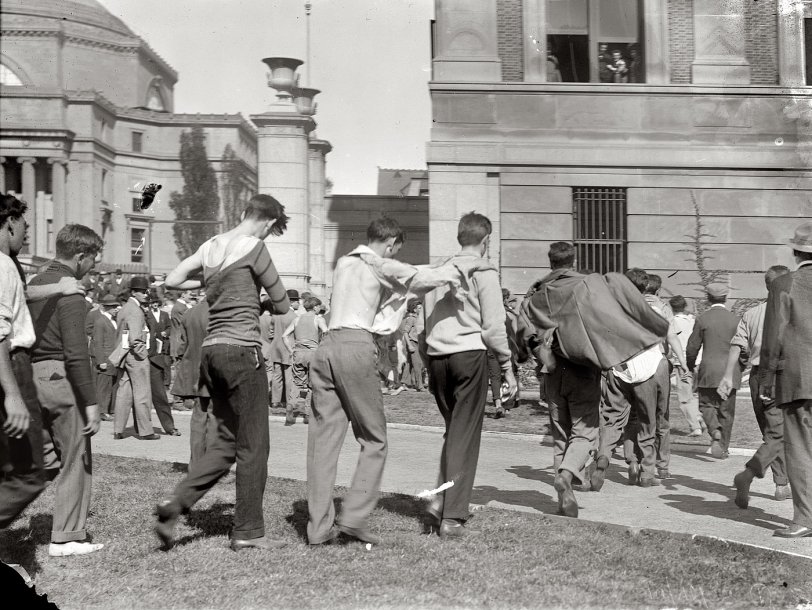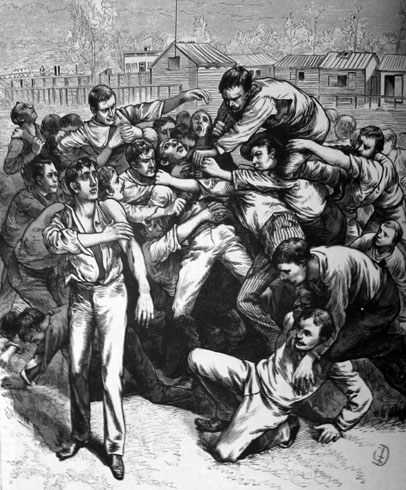


Framed or unframed, desk size to sofa size, printed by us in Arizona and Alabama since 2007. Explore now.
Shorpy is funded by you. Patreon contributors get an ad-free experience.
Learn more.

- Alas, hidden from view
- Exclusive pump
- Details, Details
- What's that building to the left of the tower?
- Coal Barges
- Bromo-Seltzer
- Inner harbor
- The Basin
- What a headache!
- Giant stepladder?
- Baldwin 62303
- Baldwin VO-1000
- Cold
- No expense spared
- Tough Guys
- Lost in Toyland
- And without gloves
- If I were a blindfolded time traveler
- Smoke Consumer Also Cooks
- Oh that stove!
- Possibly still there?
- What?!?
- $100 Reward
- Freeze Frame
- Texas Flyer wanted
- Just a Year Too Soon
- WWII -- Replacing men with women at the railroad crossing.
- Yes, Icing
- You kids drive me nuts!
- NOT An Easy Job
Print Emporium
Flag Rush: 1910

October 11, 1910. "Flag Rush, Columbia University." View full size. 5x7 glass negative, George Grantham Bain Collection. So who can tell us about "flag rush."
Columbia Cane Rush 1882
Here's an image of the 1882 Columbia College "Cane Rush" on the grounds of the Mott Haven Athletic Club in 1882. "It was traditional at Columbia that freshman not carry canes on campus before spring of their first year, under threat of attack from the upperclassmen should this prohibition be ignored. The only way around the rule was the "cane rush" held each fall... whichever side has the most hands on the cane after 15 minutes won. If the freshmen won, they were allowed to carry their canes before the spring." (From "New York in the Nineteenth Century" by John Grafton).

Flag Rush
Flag rush was similar to the Japanese game of botori, most notably played by the sophomore and freshman classes at Amherst College in Massachusetts. A small flag is set upon a padded post about 6 feet high and defended by one class while the other tries to overthrow it. If the flag is not captured or torn down within a certain time the defending side wins. This came from an earlier game almost exactly like it called cane rush, but the cane was actually very heavy and the tuffle for it could prove to be dangerous with a lot of injuries. Typically a flag rush could become "rambunctious," which is why you see disheveled hair and torn clothes.
Ripped
Looks like a few of these guys got their shirts torn up and torn off in the melee!
Columbia
looks like the view from 116th Street.
Google Foo?
http://en.wikipedia.org/wiki/Flag-rush
Basically it is capture the flag I guess.
Flag Rush at Columbia
from the New York Times, 1910
FLAG RUSH AT COLUMBIA.; Sophomores Victorious and Freshmen Come Out Short of Clothing.
"Before 1,500 people ranged along the sides of South Field yesterday the Columbia freshmen and sophomores engaged in their annual flag rush. Three five-minute periods were fought, but not a freshman was able to gain the top of the pole from which the pennant floated."
Flag rush
Flag rush was a game played between the freshman and sophomore class. It was very similar to capture the flag. Basically, it was a fight.
Three Suspended for Hazing
http://query.nytimes.com/gst/abstract.html?res=9902E7D6103AE733A25754C0A...
According to the linked article, it was an annual contest between sophomores and freshmen. Sophs put a Columbia flag in a tree and surrounded it, and the frosh tried to fight through them to get to the flag.
Flag Rush
Wiki to the rescue!
http://en.wikipedia.org/wiki/Flag-rush
Flag Rush, or Botori, was once played at naval, military and other schools. Botori is played with two sides of equal number, usually about one hundred, each of which defends a pole about 8 ft (2.4 m) high firmly set in the ground, the poles being about 200 yd. distant from each other.
Flag-rush was instituted at the request of the faculty to take the place of the traditional Cane-rush, a general fight between the two classes for the ultimate possession of a stout walking-stick, which became so rough that students were frequently seriously injured.
About Flag Rushing
This was an annual fall event at Columbia whereby the freshmen competed against the sophomores to climb a flagpole and retreive the flag for their side.
Three five minute "periods" were played, with the victorious team then performing a snake dance through the streets of New York.
A very good article describing this exact event of October 11 1910 can be found here:
http://query.nytimes.com/mem/archive-free/pdf?res=9D06E7DA1F39E333A25752...
























On Shorpy:
Today’s Top 5